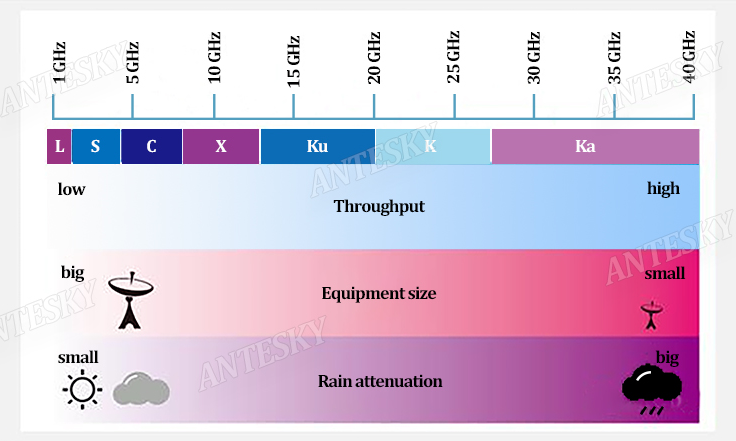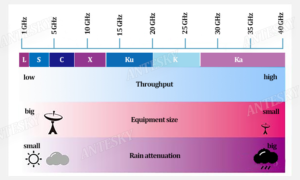
With the advent of the commercial aerospace and the development of 5G technology, the satellites frequency resources and requirements for the bandwidth and speed of data transmission are becoming increasingly tight. This has forced satellite manufacturers and operators to find and develop higher wireless communication frequency bands to meet new requirements. The Ka-band has aroused attention to them. Antesky as an professional ka antenna supplier for years, is here for showing you ka band antenna list for reference.
At the beginning, let us introduce ka band thoroughly. First of all is characteristics of Ka-band itself, and then focus on the application status and development trend of Ka-band in the field of communication satellites.
Characteristics of Ka-band antenna
The Ka-band is a band in the electromagnetic spectrum with a frequency range of 26.5-40 GHz, between super-high frequency (SHF) and extremely high frequency (EHF). Compared with traditional satellite communication frequency bands such as S, C, X etc, the Ka-band has the following characteristics.
Fig.1 Characteristics of Ka-band
- Wide available frequency band and high throughput
As shown in Figure 1, the Ka-band has a wider range than other frequency bands, has the characteristics of high throughput, and can provide wider spectrum resources to achieve more data transmission.
Compared with the low frequency band, the Ka-band development was launched later, so the frequency resources are relatively less crowded. For example, the general available bandwidth of the C band is 500MHz~800MHz; the available bandwidth of the Ku-band is 500MHz~1000MHz; and the available bandwidth of the Ka-band can reach 3500MНz.
In terms of applying for frequency licenses, low-frequency spectrum has been extensively developed, and the entry of new commercial satellite companies requires frequency coordination with the corresponding subjects to obtain the right of passage. Although the use of Ka-band frequencies may also need to be coordinated, it at least avoids the congestion and saturation of traditional frequency bands.
- Small size of terminal equipment and satellite load
The higher frequency, the larger gain of the satellite antenna. and the user terminal will be smaller and lighter, which is conducive to the promotion and application of end users.
For the ground system, based on the same receiving parameter, the antenna aperture of the Ka-band is significantly smaller than that of the low-frequency antenna, and the aperture of the ground antenna is one of the main factors that determine the input cost of the ground system. The diameter of the ground antenna becomes smaller, which can provide more economical and flexible ground data reception services.
Yes, our 1.8m ka band flyaway antenna is with smaller and lighter weight, which can be portable much easier and be cost-effective for end-user.
On the other hand, antenna size and transmitter on the Ka-band satellite is also smaller. For the satellite, it is easier to reduce the overall weight and volume of the spacecraft, reduce the launch cost, and enable the satellite to carry more payloads.
- Large rain attenuation
In addition to the significant advantages of wide communication frequency bandwidth and small terminal size, the Ka-band also has certain shortcomings. Due to the high frequency and short wavelength, the ability to bypass obstacles is poor, and it is more obviously affected by weather such as clouds, rainfall, and haze. This brings certain difficulties to the use of Ka-band in rainy areas. In order to meet the normal data capacity requirements in rainy and cloudy days, it is often necessary to receive more capacity than the actual need to compensate for the weakened signal.
2. Application of Ka–band antenna in communication satellites
Based on the characteristics of Ka high-frequency bands with high throughput and greater data transmission capacity, communication satellites can provide end consumers with low-latency, high-speed data connection services. Since the beginning of this century, communication satellite operators have begun to increase Ka-band investment, construction and launch of a series of Ka-band satellites
Like communication satellites in other operating frequency bands, Ka-band communication satellites are mainly targeted at areas that are not covered by terrestrial communications networks, as a supplement to terrestrial communications network systems. The main application includes voice messaging services in remote areas, maritime and in-flight Internet connection services, community Internet services, emergency communications, TV broadcasting services, Internet of Things data transmission, company and government agency intranets, etc.
The development of GEO orbit Ka-band communication satellite technology is relatively mature, and there are many competitors in the business market. However, due to the number and orbit restrictions of its satellites, the coverage of GEO satellites is limited, and most of them are regional operators. Please have a look for Ka-band GEO communication satellite currently in operation in orbit from below Table.1.
Table 1 Ka-band GEO communication satellites in orbit
| Satellite operator | Satellite | Launch time | Main service area | Remark |
| Viasat | WildBlue-1 | 12/2006 | North America | 35 Ka wave beam |
| ViaSat-1 | 10/2011 | US, Canada | total capacity 140Gb/s | |
| ViaSat-2 | 06/2017 | North America, Central America, Routes between America and Europe | total capacity 350Gb/s | |
| NBN | Sky Muster 2pcs/NBN-Co 1A, 1B | 10/2015
10/2016 |
Australia | total capacity 135Gb/s |
| Avanti | Hylas-2 | 08.2012 | America, Eastern Europe and Middle East | 24 Ka transponders |
| Al Yah | Yahsat-1B | 04.2012 | Middle East, Africa, Europe, Southwest Asia | 25+21Ka transponders |
| EchoStar/Hughes | EchoStar17/Jupiter 1 | 07/2012 | North America |
Multiple spot beam high throughput Ka-band load |
| EchoStar19/Jupiter 2 | 12/2016 | North America | ||
| Eutelsat | Eutelsat
Konnect |
01/2020 | Africa, West Europe | total capacity 75Gb/s |
| KaSat | 12/2010 | Europe, part of middle east | total Ka capacity 90Gb/s | |
| Kacific | Kacific 1 | 12/2019 | Asian-Pacific region | 56 Ka wave beam: total capacity 1.25Gb/s |
| Inmarsat-5 | Inmarsat-5 series the first 4 satellites | 2013-2019 | Global | 89 Ka wave beam(the first 4 satellites), 72 wave beam (the fifth satellite) |
| China Satellite Communication Co.,ltd | Zhongxing-16 | 04/2017 | China and offshore areas | China’s first high-throughput satellite: total capacity 20Gb/s |
In addition to the above-mentioned full Ka-band satellites, there are also high-throughput GEO satellites that work in the Ka&Ku band or the C-band at the same time. They are mainly used to provide satellite TV broadcasting services, including AnikF2, F3 of Telesat, Canada, and European Satellite Corporation (SES). AMC15, 16 and Serius4/Astra4A, Galaxy-28/Intelsat Americas8/Telstar8 of Intelsat, etc.
Compared with the mature GEO communication satellites, the LEO broadband satellite constellation is still in the exploratory stage, but the development prospects are worth looking forward to. Despite the recent bankruptcy of OneWeb, SpaceX’s Starlink plan is still attracting attention. The sixth group of satellites was launched in March this year, and the number of satellites in orbit has reached 360. In addition, Iridium’s second-generation Iridium system entered the commercial operation stage in 2018, mainly providing voice and data services covering the world. The domestic Ka-band low-orbit broadband satellite plans include the Aerospace Science and Technology “Hongyan” constellation, the Aerospace Science and Industry “Hongyun” constellation, and the Galaxy Aerospace Low-orbit mobile communication constellation. At present, the above three constellations have also successfully launched their first satellite. In the broadband satellite constellation system, the Ka-band is used for both the downlink feeder link and the inter-satellite link.
In addition, MEO communication satellites and GEO communication satellites show complementary trends. For example, in MEO orbit, only 03b constellation is currently in operation, and each satellite of this constellation is equipped with 12 Ka-band antennas. It has been in commercial operation since 2014 and was acquired by SES as a subsidiary in 2016. The company plans to continue to launch the MEO satellite constellation mPower in 2021, combining with its existing GEO satellites to provide broadband services with higher speeds and lower latency. The US satellite company (ViaSat) also proposed to deploy a ViaSat-3 constellation consisting of 20 satellites in MEO orbit, combined with the company’s GEO satellite capacity to optimize user experience.
The development path of Ka band antenna
Although the current development of Ka-band and above VHF-band satellite communications has not yet reached the stage of widespread application, many satellite companies have applied for V-band (downlink 37.5-42GHz; uplink 47.2-50.2GHz and 50.4-51.4GHz). ). FCC received applications for the use of V-band from a number of companies, and plans to use V-band or Ka/V-band satellite constellations of different scales in the low- and mid-orbit department as a supplement to the existing Ka-band network.
Application statistics table
| Satellite company | Orbit | Satellite quantity |
| Boeing | LEO | 132+15 |
| Space X | LEO | 4425+7518 |
| One Web | MEO/LEO | 1280+720 |
| Telesat | LEO | 117 |
| O3b/SES | Equatorial orbit | 24 |
| Viasat | MEO | 20 |
| Audacy | MEO | 3 |
| Theia Holdings | LEO | 112 |
The application for the right to use higher frequency bands is largely motivated by the preemptive occupation of frequency resources, but it also reflects the trend of future satellite operating frequency bands to higher frequency bands from another aspect. If technological breakthroughs can be made in the future to overcome the disadvantages of high frequency bands, VHF frequency bands will redefine high-throughput satellites.
For now, that is all the introduction of ka band. We are doing a series about special frequency and next we will introduce L band for you. Welcome to talk with us if you have further question via sales@antesky.com







